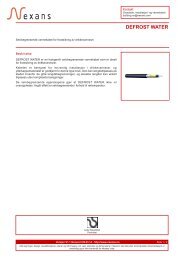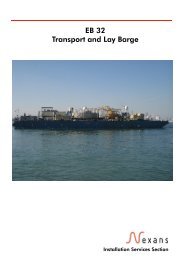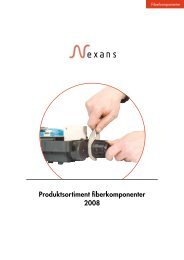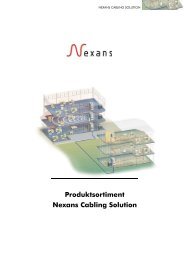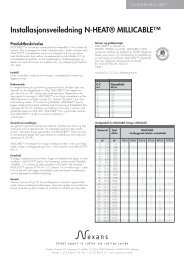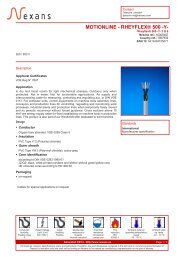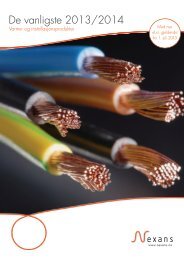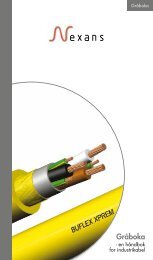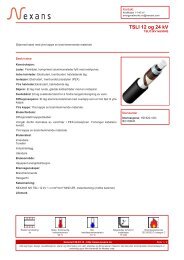5374 High Voltage Cables - Nexans
5374 High Voltage Cables - Nexans
5374 High Voltage Cables - Nexans
Create successful ePaper yourself
Turn your PDF publications into a flip-book with our unique Google optimized e-Paper software.
<strong>High</strong> <strong>Voltage</strong> <strong>Cables</strong><br />
Next
Cable installation in Lofoten in 1961<br />
<strong>Nexans</strong> Norway AS<br />
For more than eighty years, <strong>Nexans</strong> Norway AS – formerly Standard Telefon og Kabelfabrik AS (STK) – has been<br />
the principal supplier of power cables in Norway. These eight decades have seen enormous development of the<br />
country´s hydropower resources. Today, Norway´s consumption of electricity per capita is higher than that of<br />
any other country in the world.<br />
Most of the hydro-electric power stations are located in the mountains, whereas the main centres of population<br />
are in the lowland and coastal regions. Consequently, hydropower development has been accompanied by the<br />
growth of an extensive power grid for the transmission and distribution of electricity.<br />
Underground and submarine cables are important components in the power grid. Over the years, <strong>Nexans</strong><br />
Norway has acquired vast experience in manufacturing and installing power cable systems.<br />
Back to contents Next
<strong>Nexans</strong> Norway AS<br />
Cable technology in the forefront<br />
Design and engineering<br />
XLPE cables<br />
A few examples of installations<br />
Oil-filled cables<br />
Cable design<br />
A few examples of installations<br />
Development for future needs<br />
Research and development<br />
Cable accessories and installation services<br />
A full range cable supplier<br />
Back Next
Cable technology in the forefront<br />
Back to contents Next
The Halden plant<br />
The Halden plant is the main plant<br />
of <strong>Nexans</strong> Norway and is the<br />
competence center for high-voltage<br />
submarine power cables and<br />
umbilicals within Alcatel´s cable<br />
activities. At this plant, research and<br />
development are carried out on<br />
a comprehensive array of power<br />
cables.<br />
The plant, located on the Oslofjord,<br />
was built for the production of the<br />
company´s first Skagerrak cables in<br />
the early 1970´s. Since its erection,<br />
it has continuously been enlarged and<br />
upgraded in order to accommodate<br />
developments in the field of paperinsulated<br />
high-voltage cables for AC<br />
and DC applications, as well as for<br />
the production of high-voltage XLPE<br />
(cross-linked polyethylene) insulated<br />
cables, composite cables and<br />
umbilicals for the offshore industry.<br />
With a flexible layout and the most<br />
modern and efficient production<br />
machinery, the Halden plant supplies<br />
the most competitive cable system<br />
solutions to power utilities and the<br />
offshore industry the world over.<br />
Paper-insulated cables<br />
The Halden plant is equipped for<br />
handling cables of extra long length<br />
and heavy weight. The plant´s layout<br />
and processes are designed to meet<br />
all special manufacturing and<br />
handling requirements for large, highvoltage<br />
cables and umbilicals, and<br />
the facility is currently able to produce<br />
cables with conductors up to 2,500<br />
mm 2 , and paper-insulated cables for<br />
voltages up to 765 kV AC.<br />
XLPE insulated cables<br />
In 1994, an entirely new production<br />
line for XLPE cables was put into<br />
operation.<br />
The extrusion of XLPE is performed<br />
in a tower over 100 meters high.<br />
The extrusion of the conductor screen,<br />
insulation and insulation screen is<br />
performed in a single operation<br />
utilizing four extruders and one<br />
extruder head. The curing and<br />
cooling take place in a dry<br />
atmosphere of pressurized nitrogen.<br />
Special attention is given to the<br />
handling of materials, particularly in<br />
respect to cleanliness. The raw<br />
material is fed into the extruder<br />
through a completely closed system.<br />
In the manufacturing of high-voltage<br />
cables, a special super-clean grade of<br />
material is employed in order to<br />
ensure the highest degree of purity.<br />
Back to contents Next
Design and engineering<br />
Power transmission systems are of vital importance, and it is<br />
essential that they should function reliably year in and year out.<br />
Since 1915, when we entered the power cable field, we have<br />
been continuously engaged in cable production and the planning<br />
and construction of power links spanning some of the most<br />
difficult terrain in the world – trackless mountains, deep fjords<br />
and wide expanses of open sea. In these projects we have<br />
gained unequalled experience, which has helped us to devise<br />
efficient and reliable designs and processes to the benefit of our<br />
customers.<br />
<strong>Nexans</strong> Norway offers a complete<br />
range of cable designs -<br />
oil-filled, mass-impregnated and XLPE<br />
insulated for voltages from 1 kV to<br />
525 kV. We also supply a full range<br />
of cable system accessories including<br />
joints and terminations. We can<br />
undertake complete deliveries<br />
including cable laying and electrical<br />
installation with full turn-key<br />
responsibility.<br />
Public utilities all over the world now<br />
look to Norway for high voltage<br />
cables and for the solution of their<br />
problems in designing complete cable<br />
systems. They know that <strong>Nexans</strong><br />
Norway means professional<br />
performance.<br />
Back to contents Next
Engineering<br />
<strong>Nexans</strong> Norway´s standard range of<br />
cables and accessories are designed<br />
in accordance with national and<br />
international specifications, but we<br />
are fully prepared to design and<br />
supply cable systems to customer<br />
requirements.<br />
In order to make the appropriate<br />
choice of technical solution, the<br />
following parameters should be given<br />
as early as possible:<br />
1. Rated voltage.<br />
2. Maximum operating voltages.<br />
3. Insulation level (impulse withstand<br />
voltage).<br />
4. Short-cut circuit current: Transient<br />
value and steady state value (root<br />
mean square) referred to a specific<br />
duration.<br />
5. Transmitted power at rated voltage.<br />
6. Sketch giving dimensions, showing<br />
layout and profile of the complete<br />
cable alignment.<br />
7. Method of laying, thermal<br />
conditions, site conditions.<br />
8. Standards.<br />
Adjustment to local conditions and<br />
specific installation sites is our<br />
speciality, based on our experience<br />
from all over the world.<br />
Turnkey capability<br />
<strong>Nexans</strong> Norway will design a total<br />
cable system to fit any customer need,<br />
and will take full responsibility for its<br />
functioning. The company completes<br />
the entire job – start to finish – from<br />
erecting the termination site, trenches,<br />
foundations and buildings as<br />
required, to completing all electrical<br />
installations necessary.<br />
<strong>Nexans</strong> Norway employs an engineering<br />
staff of some 250 specialists<br />
in the design and installation departments<br />
and in its laboratories.<br />
The company offers a wealth of<br />
experience gained from research and<br />
development put to test during project<br />
executions around the world.<br />
For any high-voltage cable project,<br />
<strong>Nexans</strong> Norway is the natural choice<br />
as a turn-key partner.<br />
Quality<br />
<strong>Nexans</strong> Norway has established<br />
quality systems to ensure that deliveries<br />
meet agreed specifications and<br />
statutory requirements, and satisfy the<br />
needs of customers and internal users.<br />
The quality systems used in all<br />
activities leading to the delivery of<br />
products and services are certified by<br />
an accredited body (DNV) to conform<br />
to the standard BS EN ISO 9001: 1994.<br />
Health, safety and environment<br />
It is the policy of <strong>Nexans</strong> Norway to<br />
conduct all operations in accordance<br />
with the best-known safety practices in<br />
order to prevent accidents. This policy<br />
is relevant to personnel, environments,<br />
products and working equipment. All<br />
activities will be performed in<br />
compliance with prevailing legislation<br />
regarding health, safety and working<br />
environments.<br />
Although the prime responsibility for<br />
safe operation rests with management,<br />
all Alcatel units consider the promotion<br />
of accident prevention and health<br />
preservation to be a major priority for<br />
employees at every level. Therefore,<br />
awareness programs and a positive<br />
attitude towards safety are important<br />
for all members of staff and<br />
management.<br />
Back Next<br />
Husmo Foto
8<br />
XLPE cables<br />
Back to contents Next
XLPE cables<br />
In 1967 the first power cables with XLPE (cross-linked polyethylene)<br />
insulation were installed in Norway for voltages of<br />
12 and 24 kV replacing power cables insulated with PVC<br />
(polyvinylchloride), polyethylene and mass-impregnated paper.<br />
Experience in design, development and service rapidly proved<br />
their reliability. For 12 and 24 kV XLPE cables the statistics show<br />
approx. 0.09 failures per 100 three-phase circuit km per year;<br />
a remarkably low figure compared with other countries. Also for<br />
higher voltages the service experience is very good. This fact<br />
together with research and development of materials and<br />
processes has shown that technology is ready for cables at<br />
420 kV and even higher voltages.<br />
The basic advantages of XLPE<br />
insulated power cables may be<br />
summarized as follows: Because of<br />
the cross-linking the XLPE insulation<br />
can be designed for a maximum<br />
conductor temperature of 90° C and<br />
a short circuit temperature of 250° C.<br />
The extruded insulation has excellent<br />
electrical properties including low<br />
dielectric losses and allow use of<br />
simplified solutions for joints and<br />
terminations compared to oil filled<br />
cables. Thanks to the elimination of a<br />
liquid impregnant the XLPE cables are<br />
well suited for cable routes with<br />
differences in elevation requiring only<br />
standard terminations at both ends.<br />
Good mechanical properties and<br />
light weight compared with oil filled<br />
cables simplify the installation work.<br />
The key process in XLPE cable<br />
manufacture is the extrusion of the<br />
insulation system. Ever since the<br />
introduction of XLPE insulated power<br />
cables in 1967 <strong>Nexans</strong> Norway has<br />
applied the insulation in a vertical<br />
extrusion line. In the beginning the<br />
conductor screen and the insulation<br />
were extruded in a tandem operation<br />
with cross-linking process based on<br />
steam curing and water cooling.<br />
In 1979, as a result of development<br />
in process and material technology,<br />
a new vertical extrusion line was<br />
installed incorporating triple extrusion<br />
of conductor screen, insulation and<br />
insulation screen in one extruder head.<br />
Back to contents Next
Curing and cooling was changed to<br />
take place in a dry atmosphere of<br />
pressurized nitrogen. Today <strong>Nexans</strong><br />
Norway operates a vertical line<br />
where the insulation system is extruded<br />
on to the conductor by four extruders<br />
feeding the material into one extruder<br />
head.<br />
Special attention is given to material<br />
handling, particularly as regards<br />
cleanliness and temperature during<br />
storage. A special super clean grade<br />
of material which is used to ensure the<br />
highest degree of purity, is fed to the<br />
extruders in a completely closed<br />
system.<br />
The interface between the insulation<br />
and the two screens is of vital<br />
importance for the quality of the<br />
insulation system – the more so with<br />
increasing voltage levels. The interface<br />
must be smooth with a good bond<br />
between the layers. Even small<br />
protrusions may drastically reduce the<br />
electrical properties of the insulation<br />
system. The introduction of the triple<br />
extrusion tools of our own design<br />
together with optimal process control<br />
ensures smooth interface and thereby<br />
excellent electrical properties.<br />
Cable design<br />
Conductor:<br />
Underground XLPE cables used in<br />
Norway normally comprises a<br />
stranded, compacted aluminium<br />
conductor. For export markets copper<br />
is the more common conductor<br />
material and for larger conductors the<br />
segmented type of conductor<br />
(Milliken) is prevailing.<br />
Insulation:<br />
The insulation system consists of a<br />
conductor screen, the insulation layer<br />
and an insulation screen, all layers<br />
extruded in one operation.<br />
Screen:<br />
For underground cables the screen<br />
consists of round copper wires<br />
protected with an overall PE or PVC<br />
sheath.<br />
Water blocking:<br />
To protect the cables against ingress<br />
of water in case of damage the<br />
cables are provided with waterblocking<br />
material in the conductor<br />
and swelling tapes between the cable<br />
core and the metallic sheath.<br />
Metal sheath:<br />
If required the cable core is protected<br />
by a metal sheathing - either an<br />
extruded lead sheath or a metal/PE<br />
foil as a water barrier.<br />
All submarine cables for voltages<br />
above 36 kV are provided with an<br />
extruded lead sheath and the outer<br />
protection for underground cables is<br />
normally PVC or PE sheaths.<br />
Standards and testing:<br />
<strong>High</strong> voltage cables insulated with<br />
cross-linked polyethylene are normally<br />
tested at four levels:<br />
a) Type test<br />
b) Routine test<br />
c) Special test<br />
d) Testing after installation<br />
All these tests are routinely performed<br />
according to IEC 840 for service<br />
voltages from 36 to 420 kV.<br />
However, at customers´ request we<br />
are prepared to test according to<br />
other standards such as AIEC, IEEE or<br />
customer specifications.<br />
Back Next
A few examples of installations<br />
To date, <strong>Nexans</strong> Norway has manufactured more than 50.000 phase-km of XLPE cables, ranging<br />
from 12 to 300 kV, for use in Norway. Nearly 2200 km are for voltages higher than 24 kV.<br />
Norway's first 300 kV XLPE insulated cable link was commissioned as early as in 1980. The worlds<br />
largest submarine XLPE cable has been manufactured and installed by <strong>Nexans</strong> Norway in 1995<br />
between the mainland and an offshore oil platform at the Troll field.<br />
With regard to underground<br />
installations XLPE insulated power<br />
cables operating at voltages up to<br />
72 kV had been installed already in<br />
1971. 40 phase-km of 72 kV XLPE<br />
cables were installed under one<br />
contract as early as 1974. As<br />
experience grew, the advantages of<br />
XLPE cables were increasingly<br />
acknowledged, and in 1976 the first<br />
145 kV cable was installed. Four<br />
years later, in 1980. The voltage<br />
range was increased to 300 kV. Four<br />
installations at this voltage level are<br />
now in operation in Norway.<br />
Bergen City.<br />
In the city of Bergen, 78 km of 145<br />
kV underground directly buried cables<br />
without metal sheath were installed in<br />
the period 1982-1989. Conductor<br />
dimensions range from 400 to 1200<br />
mm 2 compacted aluminium. The<br />
majority of these cables are 1200<br />
mm 2 . This double circuit cable system<br />
provides one of the main electricity<br />
supply routes to the city.<br />
Oslo City.<br />
A similar installation in Oslo was<br />
completed between 1987 and 1990.<br />
The 145 kV cables, of total length 45<br />
km, were designed with a 1200 mm 2<br />
conductor, water-blocked with a<br />
compound and with a lead sheath<br />
applied over a swelling tape.<br />
USA.<br />
For Southern California Edison Co.,<br />
<strong>Nexans</strong> Norway has been an<br />
approved supplier of 69 kV XLPE<br />
cables since 1983. Some 90 km of<br />
cables with 1750 kcmils aluminium<br />
conductor in accordance with AEIC<br />
CS7 have been delivered so far.<br />
<strong>Nexans</strong> Norway has also been<br />
approved as a supplier of 115 kV<br />
XLPE cables and received its first<br />
order for such cables from SCE in<br />
1991.<br />
Indonesia.<br />
In 1983 <strong>Nexans</strong> Norway installed<br />
150 kV XLPE insulated power cables<br />
in transformer stations in Jakarta,<br />
Indonesia. <strong>Cables</strong> and accessories<br />
were installed by <strong>Nexans</strong> Norway's<br />
own jointers.<br />
Zimbabwe.<br />
In 1987, 88 kV XLPE insulated power<br />
cables were supplied to the Central<br />
African Power Corporation, CAPCO,<br />
Zimbabwe. These cables were<br />
installed by CAPCO´s jointers.<br />
Taiwan.<br />
In 1991 and 1994 a total of 8,4 km<br />
170 kV XLPE cables and 57 GIS<br />
terminations were installed in the Nan<br />
Pu Power Station in Taiwan (in cooperation<br />
with Siemens AG).<br />
Back to contents Next
India.<br />
In 1996 and through 1997 <strong>Nexans</strong><br />
Norway supplied some 20 km of 220<br />
kV XLPE underground cables to Tata<br />
Electric Power company in Bombay,<br />
India.<br />
Submarine cables.<br />
Although the majority of XLPE cables<br />
in Norway are laid underground, we<br />
have completed many installations of<br />
more specialized types, mainly<br />
submarine links.<br />
As early as 1971 a 900 m submarine<br />
XLPE cable, rated at 12 kV, was laid<br />
across the Tromsøsund in North<br />
Norway. This cable, which had no<br />
metal sheath, was retrieved for<br />
laboratory examination after 10 years<br />
in service. When subjected to testing<br />
by short term AC, DC and impulse<br />
voltages, no significant reduction in<br />
the breakdown voltage could be<br />
detected, as compared with a new<br />
cable.<br />
A 72 kV three-core cable submarine<br />
cable with individual lead sheaths on<br />
each core was installed in 1977. In<br />
1981 a 14 km 24 kV three-core XLPE<br />
insulated submarine cable was<br />
installed in one single length. Two<br />
years later a 18 km cable of a similar<br />
design was installed. Over the years<br />
some 1100 phase-km of submarine<br />
cables have been installed, 44<br />
installations have been for voltages<br />
from 36 to 145 kV.<br />
The first 145 kV XLPE insulated<br />
submarine cables were installed in<br />
1981. In 1982 and 1983 two more<br />
installations were performed. The<br />
three 1200 m single-core cables for<br />
the first project were designed with<br />
lead sheath as a water-impermeable<br />
barrier. For the other project with a<br />
route length of 1000 m the customer<br />
did not require a lead sheath.<br />
No problems have occurred during<br />
the service of either project. Up to<br />
now <strong>Nexans</strong> Norway has performed<br />
10 submarine cable installations at<br />
145 kV.<br />
Fairly early the XLPE insulated<br />
submarine cables were adapted by<br />
the offshore industry. In 1981 a 7 km<br />
three core cable at 35 kV was<br />
installed for Texaco Inc. Between two<br />
platforms in Santa Barbara channel in<br />
California, U.S.A. In 1982 2 lengths<br />
of 12 kV cables were laid between 3<br />
platforms off the west coast of Africa<br />
for Saga Petroleum Benin Inc.<br />
In 1983, a 20-km 12 kV three-core<br />
cable incorporating control cables<br />
was installed at the Frigg offshore oil<br />
and gas field in the North Sea to link<br />
the unmanned control station at the<br />
North East Frigg field to the main<br />
Frigg field platform. Because the<br />
unmanned control station was<br />
designed as a single-point moored<br />
tower, the cable had to be designed<br />
to withstand the relative movement of<br />
the base structure of the tower and the<br />
seabed, approx. 5 million bending<br />
cycles per year. No failure has<br />
occurred since installation.<br />
In 1987, two 24 kV submarine threecore<br />
cables approx. 4 km in length,<br />
with integrated fibre-optic elements,<br />
were installed between two oil<br />
production platforms in the North<br />
Sea, Gullfaks A and B.<br />
A number of XLPE insulated submarine<br />
cables have been supplied to the<br />
offshore fields in the North Sea,<br />
Malaysia and Saudi Arabia. Among<br />
the special installations was the big<br />
dynamic composite cable for the<br />
Veslefrikk field and the worlds longest<br />
XLPE insulated submarine cable for<br />
the Troll field.<br />
This three-core 52 kV cable was<br />
installed between the Troll offshore<br />
gas platform in the North Sea and the<br />
west coast of Norway. With a max.<br />
water depth of 350 m and a route<br />
length of 67 km, this is the worlds<br />
longest XLPE submarine cable.<br />
So far <strong>Nexans</strong> Norway has installed<br />
XLPE submarine cables down to<br />
420 m water depth.<br />
Back Next
Oil-filled cables<br />
Back to contents Next
Cable design<br />
The first oil-filled cables from <strong>Nexans</strong> Norway were delivered in<br />
1938. In 1952 we manufactured and installed oil-filled cables for<br />
245 kV. Up to the present time, we have completed an impressive<br />
number of installations for service voltages up to<br />
525 kV, and one objective of our current research is to further<br />
extend this voltage range. Our broad base of experience<br />
comprises installations of every kind, from conventional<br />
underground systems, tunnel installations, vertical shafts more<br />
than 300 m deep without stop joints, to world records in<br />
submarine cable installations in Norway and abroad.<br />
Various types of high voltge AC<br />
power cables are often referred to as<br />
“oil-filled cables”. The type manufactured<br />
by <strong>Nexans</strong> Norway is<br />
commonly described as “self-contained<br />
low pressure oil-filled cable”<br />
with paper dielectric impregnated<br />
with a low-viscosity oil and<br />
incorporating a longitudinal duct to<br />
permit oil flow along the cable. The<br />
superior electrical qualities of this<br />
type of cable have been proven<br />
through more than 70 years of<br />
service experience.<br />
Electrical and mechanical properties<br />
have been continuously improved by<br />
the introduction of new and better<br />
materials and advanced production<br />
techniques.<br />
Our factory in Halden, by the<br />
Oslofjord, is equipped with modern<br />
and efficient production machinery,<br />
ensuring optimum product quality.<br />
The factory is capable of producing<br />
cables of the largest sizes, both as<br />
regards conductor dimension and<br />
external diameter, and for the highest<br />
voltages. The layout of the factory<br />
allows for highly flexible production<br />
to suit customers´ individual<br />
requirements, and special equipment<br />
is provided for the handling of long<br />
and heavy cables. Thus even 525 kV<br />
cables can be manufactured in<br />
jointless lengths of 18-20 km.<br />
Back to contents Next
Cable design<br />
For rated potentials up to 145 kV,<br />
both three-core and single-core cables<br />
are used. Above 145 kV, all cables<br />
are of the single-core type.<br />
Conductor<br />
The conductor consists of concentric<br />
layers of helically wound key-stone<br />
shaped copper or aluminium wires.<br />
This structure combines excellent<br />
mechanical stability with a smooth<br />
surface, which is important in the<br />
application of the insulation.<br />
Insulation<br />
Oil-filled cables are insulated with<br />
cellulose paper impregnated with<br />
mineral or synthetic oil.<br />
Metal sheath<br />
The sheaths that serve to prevent<br />
water from penetrating the paper<br />
insulation are metal alloys. Of these,<br />
arsenic lead alloy F-3 (0,15 %<br />
arsenic, 0.1% tin, 0.1% bismuth,<br />
99.65% lead) has proved the most<br />
suitable, thanks to its favourable<br />
mechanical properties (resistance to<br />
vibration, low creep, etc.). This alloy<br />
has been used for all high voltage oilfilled<br />
cables manufactured by <strong>Nexans</strong><br />
Norway for the last 30 years. Other<br />
alloys may be used at customer´s<br />
request.<br />
Reinforcement<br />
One of the characteristic advantages<br />
of oil-filled cables is that they can be<br />
designed to suit different cable routes<br />
and installation sites. To cater for<br />
differences in route elevation, suitable<br />
metal reinforcement, normally<br />
stainless steel tape, may be applied<br />
over the metal sheath. For cables<br />
designed for installation in tunnels or<br />
shafts, a combination of longitudinal<br />
and transverse reinforcement has<br />
been developed.<br />
Outer protection<br />
Outer protection of underground<br />
cables normally consists of an<br />
extruded polyethylene jacket.<br />
Standards and testing<br />
Oil-filled cables and accessories are<br />
normally designed and tested in<br />
accordance with IEC Publication<br />
141-1: “Tests on oil-filled and<br />
gaspressure cables and their<br />
accessories”. As required, oil-filled<br />
cables and accessories can be<br />
manufactured and tested in<br />
accordance with specific national<br />
standards or customer requirements.<br />
Back Next
A few examples of installations<br />
The topograhy of Norway is such that cables often have to be laid along routes with large<br />
differences of level, and we have installed 36 - 420 kV cables with static pressures varying from<br />
30 kp/cm2 at one end to 0.2 kp/cm2 at the other end. Systems of this kind have been installed at<br />
several underground power stations in Norway. Our wide experience in the field of oil-filled cables<br />
formed the basis for major export contracts including vertical shaft installations. A few examples<br />
are given here:<br />
TVA, Racoon Mountain<br />
In 1976 <strong>Nexans</strong> Norway installed 14<br />
SCOF 161 kV 3250 MCM (1647<br />
mm 2 ) cables at Racoon Mountain<br />
Pumped Storage Plant near<br />
Chattanooga, for the Tennessee<br />
Valley Authority. Average route length<br />
between switchyard and powerhouse<br />
is 640 m, with a 305 m vertical shaft.<br />
PG&E, Helms Project, California<br />
In 1981/82 <strong>Nexans</strong> Norway<br />
installed 10 single-core, oil-filled 230<br />
kV 2000 MCM (1013 mm 2 ) cables<br />
for Pacific Gas & Electric Co at Helms<br />
Pumped Storage Plant in the Sierra<br />
Nevadas. The cables connect the<br />
switchyard and the powerhouse and<br />
are installed in a 300 m vertical shaft.<br />
Average route length is 450 m. The<br />
operating pressure of the cables is 30<br />
bar.<br />
PLN, Jakarta, Indonesia<br />
In the period 1983 to 1985 <strong>Nexans</strong><br />
Norway installed two double circuit<br />
routes with 150 kV cables in Jakarta,<br />
9.3 km and 5.6 km route length<br />
respectively, requiring a total of 94.8<br />
km of cable. The routes go through<br />
very congested areas, generally with a<br />
high water table, putting installation<br />
performance to the test. Installation of<br />
a third double circuit route, approx.<br />
12 km long was completed in 1990.<br />
City of Oslo<br />
In the late 1960s, the steady rise in<br />
Oslo´s peak load necessitated<br />
reinforcement of the links between<br />
substations around the city. In 1969,<br />
2000 m 2 aluminium conductor cables<br />
operating at 300 kV were installed as<br />
a part of the main feeder around<br />
Oslo. The 9 km installation was<br />
divided into three separate hydraulic<br />
sections and seven crossbonding<br />
sections.<br />
Singapore<br />
In 1984/86 <strong>Nexans</strong> Norway<br />
installed four circuits of 230 kV oilfilled<br />
power cables in a tunnel<br />
beneath the busy shipping channel of<br />
East Jurong Fairway, from Seraya to<br />
the main island of Singapore. Each<br />
circuit, comprising three cables with<br />
2000 mm 2 copper conductors<br />
transmits 500 KVA.<br />
The cables were installed without<br />
joints. The 2.6 km lengths were<br />
transported in 150-tonnes steel<br />
baskets and pulled into the tunnel by<br />
means of 60 synchronized pulling<br />
machines along cable ducts cast in<br />
the tunnel floor. To perform this<br />
exacting task, <strong>Nexans</strong> Norway<br />
employed a technique specially<br />
developed for projects of this kind.<br />
Back to contents Next
The Vancouver Project - the highest<br />
voltage and capacity<br />
From 1982 to 1984, 234 kilometers<br />
of 525 kV AC oil-filled submarine<br />
cable were installed between<br />
Vancouver Island and mainland<br />
British Colombia, Canada. Both the<br />
system voltage of 525 kV and the<br />
transmission capacity of 1200 MVA<br />
for a single circuit are the highest<br />
achieved in submarine cable<br />
installations ever. Six single-core<br />
cables were installed in the cable<br />
route of 30 and 9 kilometers.<br />
C/S Skagerrak was used for the<br />
project, after having been rebuilt for<br />
world-wide voyages, adjusted for<br />
passing through the Panama canal<br />
and equipped with dynamicpositioning<br />
equipment.<br />
<strong>Nexans</strong> Norway participated in<br />
producing 50 percent of the cables,<br />
and performing the entire laying<br />
operation.<br />
The Oslofjord, Norway<br />
From 1959 to 1980, the Norwegian<br />
Water Resourses and Electricity Board<br />
installed three high-voltage submarine<br />
cable systems manufactured by<br />
<strong>Nexans</strong> Norway to strenghten the<br />
power transmission network on both<br />
sides of the Oslo Fjord and the link<br />
between the Norwegian and Swedish<br />
transmission grids.<br />
In 1959 and 1960, six 300 kV<br />
cables were laid across the fjord,<br />
transmitting a total of 730 MVA. In<br />
1974 and 1975, six 420 kV cables<br />
were installed with the added<br />
transmission capacity of 1710 MVA.<br />
Finally in 1980, another six 420 kV<br />
cables (two circuits) with the added<br />
transmission capacity of 1650 MVA<br />
were installed. The route length is six<br />
by 17 kilometers.<br />
Kafue Gorge, Zambia<br />
In 1989, <strong>Nexans</strong> Norway<br />
participated in the restoration of the<br />
cable links at the Kafue Gorge Power<br />
Station, Zambia´s principal source of<br />
power supply.<br />
The urgency of this assignment led to<br />
a decision to transport the 33-tonnes<br />
cable drums by air. One of the<br />
world´s largest aircraft, the Antonov<br />
124, was chartered to lift the 345 kV<br />
oil-filled cables from Norway to<br />
Lusaka airport. This was probably the<br />
first transport of its kind in the history<br />
of high voltage cable installation.<br />
With responsibility for the second and<br />
third restoration stages, each<br />
comprising 300 MW transmission<br />
links operating at 345 kV, <strong>Nexans</strong><br />
Norway has confirmed its capabilities<br />
in serving customers at distant<br />
locations and under tropical site<br />
conditions.<br />
Bergenshalvøens Kommunale<br />
Kraftselskap<br />
In 1995 <strong>Nexans</strong> Norway supplied<br />
300 kV LPOF cables for a total route<br />
length of 15 km for one of the largest<br />
Norwegian power utilities. Due to the<br />
crossing of an environmentally sensitive<br />
area an underground cable system<br />
was chosen instead of overhead lines.<br />
Saudi Aramco<br />
In 1996 <strong>Nexans</strong> Norway supplied<br />
two circuits 230 kV oil-filled cables<br />
with joints and outdoor sealing ends<br />
etc. for the Saudi Aramco´s oil<br />
refinery at Ras Tamera. Installation of<br />
the system took place in cooperation<br />
with local sub-contractors in 1997.<br />
Aqaba Bay<br />
In 1997 <strong>Nexans</strong> Norway supplied<br />
and installed a total of 53 km of 420<br />
kV oil-filled cables across the Aqaba<br />
Bay between Egypt and Jordan. The<br />
crossing has a max water depth of<br />
840 m which is a world record for<br />
LPOF submarine cables.<br />
Back Next
Development for future needs<br />
Back to contents Next
Research and development<br />
It is <strong>Nexans</strong> Norway´s philosophy to focus on customers<br />
needs which lie ahead. Development of products and services<br />
is an inseparable part of the company´s goals and<br />
objectives, as well as a part of its daily work.<br />
Beside testing our own products, we offer<br />
domestic and foreign customers facilities<br />
for the testing of virtually any type of<br />
component for power transmission<br />
systems.<br />
<strong>High</strong>-voltage laboratory<br />
New goals have led to the investment in<br />
an advanced high-voltage laboratory at<br />
the company´s Halden plant. This new<br />
laboratory - unique in its size and level of<br />
technology - is equipped with the latest<br />
appliances for the electrical testing of<br />
high-voltage components in accordance<br />
with international standards for rated<br />
voltages up to 765 kV AC and<br />
800 kV DC. Flexible use of floor space is<br />
ensured by equipment being moved with<br />
the help of air cushions.<br />
The laboratory plays a key role in<br />
making the Halden plant an important<br />
center in the field of high-voltage<br />
technology.<br />
Back to contents Next
Materials research and<br />
development center<br />
This center brings together the<br />
disciplines of metallurgy, instrumental<br />
and chemical analysis as well as the<br />
electro-technical testing of materials,<br />
models and polymeric technology.<br />
Besides serving the high-voltage cable<br />
production in Halden, the center acts<br />
as a service unit for all divisions in<br />
<strong>Nexans</strong> Norway and is a<br />
coordinating link to other cable plants<br />
within Alcatel Cable as regards<br />
special materials analysis.<br />
As a part of the competence center<br />
for submarine and offshore cables<br />
and umbilicals within the cable group,<br />
the center is also responsible for<br />
research and development within<br />
these product ranges. It is continuously<br />
involved in the study of the electrical<br />
and mechanical properties of<br />
materials used in special cables<br />
produced today, as well as for future<br />
products.<br />
The center operates four different units:<br />
- Chemical laboratory<br />
- Electro-technical laboratory<br />
- Materials- and extrusion technical<br />
laboratory<br />
- Metallurgical laboratory<br />
Mechanical tensile, bending and<br />
torsion testing is performed on fullscale<br />
prototype cable samples in a<br />
test plant which simulates laying and<br />
service conditions. Tension is applied<br />
from a hydraulic piston to a maximum<br />
of 150 tonnes, and the cable is bent<br />
around different sheaves - with<br />
diameters of 1.5 to 10 meters - in<br />
order to simulate the stress induced<br />
around the laying wheel of the cablelaying<br />
vessel.<br />
These advanced laboratories form the<br />
basis for <strong>Nexans</strong> Norway´s<br />
engineering research and product<br />
development and offer power utilities<br />
and the offshore industry the top-notch<br />
testing facilities needed during all<br />
stages of a project.<br />
Back Next
Cable accessories and<br />
installation services<br />
For all cable installations, we offer purpose-designed<br />
accessories, manufactured and tested in accordance with<br />
the same international standards as the cable itself,<br />
in most cases IEC standards.<br />
Accessories<br />
We supply purpose-designed<br />
accessories for each particular cable<br />
system. All our accessories are<br />
manufactured and tested in accordance<br />
with international recommendations<br />
(mainly IEC). As essential<br />
components of transmission systems,<br />
their quality is of the utmost importance.<br />
Joints and terminations for oil-filled<br />
cables are type-tested for system<br />
voltages up to 525 kV, for XLPE<br />
cables up to 420 kV. We supply<br />
transition joints for the connection of<br />
oil-filled cables to XLPE types, and<br />
systems for cross-bonding of sheaths.<br />
Our range also includes oil-immersed<br />
sealing ends and connections to SF 6<br />
insulated busbar systems up to<br />
420 kV.<br />
For detailed information about our<br />
range of cable accessories, see<br />
separate brochures dealing with<br />
accessories for oil-filled and XLPE<br />
insulated cables.<br />
Back to contents Next
For oil-filled cable systems, <strong>Nexans</strong><br />
Norway designs pressure systems for<br />
relevant site conditions including<br />
necessary stop joints, oil pressure<br />
tanks or pumping plants,<br />
oil-feeding systems and relevant<br />
alarm and monitoring equipment.<br />
Based on extensive experience with<br />
the installation and maintenance of<br />
oil-filled power cable systems, <strong>Nexans</strong><br />
Norway has recently designed and<br />
put into operation a number of<br />
modular pumping plants used to<br />
maintain oil pressure in oil-filled<br />
cables.<br />
These simplified-design plants have<br />
separate modules for each cable, with<br />
main pressure modules used as<br />
a back-up system. A programmable<br />
logic controller (PLC) unit is used for<br />
control functions during operating<br />
conditions and should an emergency<br />
situation arise, it alarms and prints to<br />
the nearest manned control center.<br />
It has been a design criteria to ease<br />
supervision and reduce maintenance<br />
of the pumping plant, thus increasing<br />
the reliability of the cable system and<br />
minimising outage time. Experience<br />
with the company´s new pumping<br />
plant has already proven outstanding<br />
performance and has lead to repeat<br />
orders from our Norwegian customers<br />
and the first installations abroad.<br />
Installation capability<br />
The installation of oil-filled or XLPE<br />
power cables requires a staff of<br />
experienced engineers and teams of<br />
qualified jointers with specialised<br />
tools and equipment for the job.<br />
Our installation department<br />
undertakes cable laying and<br />
protection, complete electrical<br />
installation and commissioning in<br />
accordance with customers´<br />
requirements.<br />
Our engineers and jointers have<br />
extensive experience from a wide<br />
variety of installations - underground,<br />
tunnel and submarine - in Norway<br />
and worldwide, in conditions and<br />
climates of every kind. For detailed<br />
information, see our reference lists<br />
and separate brochure on submarine<br />
cable installations.<br />
We have developed special tools,<br />
equipment and techniques for<br />
- handling of exceptionally long<br />
cables in underground and tunnel<br />
installations.<br />
- handling of exceptionally long<br />
length pulling ashore operations.<br />
- handling and installation of long<br />
cables in vertical shafts, i.e. with<br />
very high pressures at the<br />
lower end.<br />
Back Next
A full range cable supplier<br />
<strong>Nexans</strong> Norway is a technologically advanced company<br />
operating four complete cable factories, all fully automated and<br />
able to meet nearly every power and telecommunication cable<br />
requirement. In addition to its main Halden plant, the company<br />
operates the three following plants.<br />
The Namsos Plant – Low- and<br />
medium voltage cables<br />
At this plant in central Norway,<br />
<strong>Nexans</strong> Norway employs the very<br />
latest in manufacturing techniques for<br />
low and medium-voltage power<br />
cables. The production range covers<br />
a standard range of installation<br />
cables up to 1 kV and power cables<br />
for 12, 24, and 36 kV.<br />
The plant is unique in its operating<br />
efficiency and flexibility.<br />
The granulated-plastic raw materials<br />
are transported in pipelines from<br />
central storage tanks to extruders.<br />
The entire production run is highspeed,<br />
while the production line is<br />
easily adjustable. In addition, an<br />
internal computer-operated system of<br />
Automatically Guided Vehicles<br />
(AGVs) guarantees a smooth and<br />
efficient transport flow.<br />
Back to contents Next
The Rognan Plant –<br />
Communication cables<br />
The development and manufacturing<br />
of communication cables takes place<br />
at the Rognan plant, north of the<br />
Polar Circle.<br />
The product range covers conventional<br />
copper cables and fibre optic cables;<br />
however, more and more of the<br />
activity is related to special telecom<br />
cables basically used in the offshore<br />
industry or in submarine telecom<br />
systems.<br />
The main products and areas of<br />
applications are fibre optic submarine<br />
cables for repeaterless system (>300<br />
km), electrical umbilical cables or<br />
opto/electrical umbilicals, elements for<br />
composite structures like power + fibre<br />
or steel tubes + fibre + copper,<br />
dynamic umbilicals for operation of<br />
Remotely Operated Vehicles (ROV`s),<br />
seismic cables, special telecom<br />
topside cables (fire resistant and mud<br />
resistant).<br />
Expansion, investment in new and<br />
efficient production equipment, strict<br />
quality control and product<br />
development have been significant<br />
factors in the plant becoming an<br />
efficient manufacturer able to adapt to<br />
customer requirements.<br />
Back<br />
<strong>Nexans</strong> Norway is today one of the<br />
world leaders in the field of<br />
repeaterless submarine fiber-optic<br />
cables with accumulated supplies of<br />
some 5.000 km of cable.<br />
In addition to supply of cables the<br />
division undertakes engineering tasks<br />
related to accessories<br />
(joints/terminations/special tooling)<br />
required for installation and<br />
maintenance purposes. Also,<br />
extensive test facilities are available<br />
in-house to ensure proper qualification<br />
of cable designs.<br />
The Langhus Plant – Low voltage<br />
cables and heating systems<br />
In 1992, a new manufacturing plant<br />
and central warehouse was<br />
established in Langhus, outside Oslo.<br />
This plant´s product range covers<br />
installation cables in the 1 kV range,<br />
as well as heating cables - comprising<br />
more than 450 different types of<br />
cables altogether. <strong>Nexans</strong> Norway is<br />
the market leader for these products<br />
in Norway, and exports them on a<br />
world-wide basis as well.<br />
One special range of product made<br />
at the plant is halogen-free safety<br />
cables for industrial and domestic use<br />
onshore. During a fire, these cables<br />
are virtually gas-free and smokeless,<br />
making escape routes safer and<br />
preventing corrosion in expensive<br />
equipment.<br />
New technology and demands have<br />
led to the creation of a unique<br />
environment for ongoing product<br />
development at the plant. Machinery<br />
and facilities have been erected for<br />
efficient and automated production,<br />
which has been carefully adapted to<br />
varying market requirements.<br />
The Langhus Plant is also the logistic<br />
center of <strong>Nexans</strong> Norway. The<br />
central warehouse is designed to<br />
serve our customers with flexible and<br />
efficient distribution of more than<br />
1,000 different products.<br />
It compromises a computer controlled<br />
high bay storage facility, shelf storage<br />
for cables of smaller diameters, and a<br />
covered outdoor shelf storage area<br />
for the larger types of cables.



